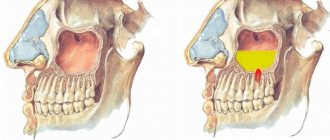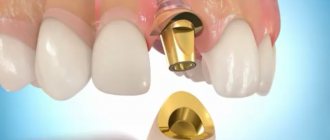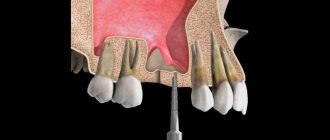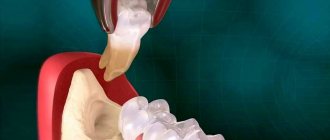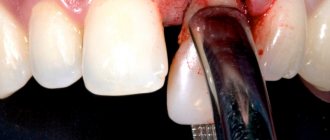Modern possibilities in dentistry solve the problems of restoring the integrity of the dentition, normalizing chewing function, the aesthetics of a smile and correct diction.
Implantation of lost teeth is an anatomically correct procedure, unlike removable dentures. In addition, the patient does not experience the hassle of caring for the prosthesis. However, such an operation requires the fulfillment of conditions that will ensure a reliable result. Thus, the lack of bone volume in the jaw prevents the operation or is considered a limitation.
Innovations in the field of dentistry make it possible to restore the necessary bone volume - osteoplasty is performed first. The method depends on the location of the planned implantation and the volume of missing tissue.
What is a sinus lift?
Sinus lifting (sinus floor elevation) is a procedure for increasing bone tissue in the area of the maxillary sinuses. They are located on the upper jaw to the left and right of the nose. In most people, the roots of the chewing teeth of the upper jaw are initially located in the maxillary sinuses, so after the removal of these teeth there is not enough bone tissue to install an implant. Closest to the maxillary sinuses are the molars (sixth and seventh teeth), less often the premolars (fourth and fifth teeth), and sometimes the canines.
The orthopantomogram shows the boundaries of the bottom of the maxillary sinuses and the apex of the alveolar ridge. There is not enough bone tissue to install implants.
Indications
To install an implant, a minimum of 10 mm of bone tissue is required to the maxillary sinus. Otherwise, a rise in its bottom is shown.
1) If the distance to the sinus is 8-10 mm, it is possible to perform a closed sinus lift with simultaneous installation of implants. The term “closed” means that no additional incisions are required. This can be compared to endoscopic operations. The postoperative period is easier.
2) If there is bone tissue from 5 mm to 8 mm, an open sinus lift (classic version) is performed with simultaneous installation of implants. This technique creates access to the maxillary sinus from the cheek. Its mucous membrane is peeled off, lifted, and bone-substituting material is placed in the resulting space, which is absorbed and replaced with its own bone.
3) If the distance to the maxillary sinus is less than 5 mm, an open sinus lift is performed without installing implants. For immediate installation of implants, a sufficient volume of bone tissue is required in which they will be stabilized. If it is not enough, then the bone volume is first increased. After 6-9 months, implants are installed. After another 6 months, crowns are installed on the implants. With severe atrophy of bone tissue in the upper jaw, the treatment period can be more than a year.
As with any surgical procedure, a number of potential complications of the sinus lift procedure can interfere with normal sinus function. It is important to understand the function of the maxillary sinus and how it is affected by the procedure. The method has limitations. General and surgical risk factors should always be considered and discussed with patients before deciding to undergo surgery.
Proper function of the maxillary sinus depends on a delicate balance between mucus production and transport by the ciliated epithelium, ventilation of the sinuses, and sustained drainage through the ostium. Any factor that affects one of the above functions may create a contraindication to a sinus lift.
The sinus lift procedure usually does not affect sinus function when performed on a healthy sinus; otherwise, the procedure may promote fluid retention and bacterial overgrowth, leading to worsening sinusitis.
Moreover, the presence of bulky masses such as polyps, tumors and hyperplastic changes in the mucosa represents an obstacle to treatment. Pre-existing local pathological conditions constitute relative or absolute contraindications to the sinus lift procedure and should be analyzed immediately before surgery.
A sinus lift is performed to install dental implants and install implant-supported dentures. Therefore, any contraindications to dental implantation in general should be initially studied.
Finally, as with all surgical procedures, the patient's overall health must be assessed. All patients undergoing sinus surgery should undergo a thorough medical examination. The extent and type of surgery, type of anesthesia, and general health before surgery greatly determine the likelihood of a favorable outcome.
Local contraindications for sinus lift
Local contraindications are divided into two main groups - potentially reversible and irreversible. The first group includes pathologies that, if treated, may allow a sinus lift. The second group consists of pathologies that, even after surgical treatment, suggest irreversible dysfunction of the osteomeatal complex.
Potentially reversible, relative contraindications
Certain anatomical and/or structural changes of the nasomaxillary complex may interfere with normal ventilation and mucociliary clearance of the maxillary sinus. Compensation may occur over time, leaving such abnormalities clinically undetectable or with mild to moderate, sometimes intermittent, symptoms. The sinus lift procedure in this setting of decompensated sinus may cause mucus retention, infection, and subacute sinusitis.
Raising the sinus floor and/or changing sinus anatomy can sometimes result in better drainage when mild mucosal dysfunction is present. But in general, changes in the function of the maxillary sinus mucosa and osteomeatal complex should be identified and treated before treatment.
It is imperative that patients undergo a thorough x-ray examination to identify sinus pathology and anatomical abnormalities. Computed tomography (CT), radiographs, and medical history are part of a comprehensive patient evaluation.
Positive radiological findings include:
- narrowing of the osteomeatal complex due to deviated septum;
- abnormal morphology of the middle turbinate;
- enlargement of the air cell in the sinus vault (Haller cell);
- bullous transformation of the middle turbinate;
- medial or lateral rotation of the uncinate process;
- enlargement of the ethmoidal bulla with narrowing of the uncinate process;
- post-traumatic or post-operative scarring.
Local contraindications also include benign tumors of the naso-maxillary complex, such as papillomas, schwannomas, osteomas, polyps and cysts. Malignant processes are always considered a contraindication. Viral, bacterial and mycotic rhinosinusitis, including those caused by an intrasinusal foreign body, require preliminary treatment.
Etiotropic treatment (for example, endodontic dental treatment, medical and surgical treatment of sinusitis, removal of tumors or polyps) should eliminate the pathological condition before sinus lifting.
Treatment of the affected sinus may require functional endoscopic surgery. This approach corrects anatomical or structural changes in the nasomaxillary complex and removes pathological sinus tissue that is otherwise resistant to treatment. After functional endoscopic sinus surgery, if radiographic and/or endoscopic findings demonstrate resolution of pre-existing pathology, a sinus lift procedure can be performed.
Irreversible, absolute contraindications
Certain anatomical and structural changes or pathologies of the nasomaxillary complex may represent absolute contraindications to the sinus transplantation procedure. This list of pathologies includes:
- serious (uncorrectable) deformities of the maxillary sinus;
- scarred and hypofunctional sinus mucosa after injury or surgery;
- radiation therapy of the head and neck area (radiation dose more than 45 Gy);
- chronic sinusitis with or without polyposis, which impairs mucociliary clearance and is not amenable to medical/surgical treatment;
- local manifestation of a systemic granulomatous disease such as Wegener's granulomatosis or idiopathic midline granuloma;
- benign but locally aggressive tumor (eg, ameloblastoma, myxoma, desmoplastic fibroma, inverted papilloma);
- malignant tumor, both primary and metastatic, originating from epithelial, connective and odontogenic tissues (squamous cell carcinoma, esthesioneuroblastoma, adenoid cystic carcinoma, adenocarcinoma, sarcoma);
- sarcoidosis, etc.
When planning a sinus lift, one should take into account any diseases that could potentially impair mucociliary function themselves or require aggressive treatment that leads to corresponding impairments.
Intraoral contraindications to sinus lift
Abnormal oral conditions may compromise the sinus lift procedure and/or the survival of dental implants placed in treated sinuses.
The list of intraoral contraindications includes:
- grossly inadequate oral hygiene or the patient's inability to maintain or maintain adequate oral hygiene;
- serious periodontal disease of adjacent teeth without appropriate treatment;
- rough overbite and insufficient space for restoration;
- severe pathological parafunctional habit (bruxism);
- fulminant lesions of the mucous membrane (lichen planus);
- severe xerostomia of any etiology.
These contraindications are, in general, similar to the contraindications that are recommended to be taken into account when installing implants that are not aimed at the maxillary sinuses.
Other diseases and conditions to consider
A patient's general health may be a relative or absolute contraindication to a sinus lift. Generally speaking, systemic problems such as an increased risk of myocardial infarction, hypertensive crisis, or sudden hypoglycemia make surgery risky.
The procedure should be avoided in patients with impaired tissue healing, such as patients with uncontrolled diabetes mellitus, immunocompromised individuals, and patients receiving antitumor chemotherapy with cytotoxic drugs.
The following conditions, if not treated and managed with the patient's full understanding of the risks, are usually a contraindication to the procedure:
- chronic kidney disease;
- chronic liver diseases with dysfunction;
- uncontrolled diabetes mellitus;
- uncontrolled arterial hypertension;
- hemophilia or treatment with anticoagulants;
- disorders of bone tissue metabolism;
- uncontrolled thyroid disease;
- uncontrolled adrenal dysfunction;
- weakened immune system, including HIV/AIDS;
- treatment with corticosteroids during sinus lift;
- chemotherapy for the treatment of malignant tumors;
- high-dose radiation therapy, local irradiation of the upper jaw;
- drug, tobacco or alcohol abuse;
- the patient’s inability to comply with the doctor’s recommendations;
- severe mental disorders;
- pregnancy period.
Sinus lift for heart attack and other heart diseases
A history of myocardial infarction, especially a recent myocardial infarction (within the previous 6 months), may be a contraindication. With the exception of recent myocardial infarction, after careful analysis of ventricular function, patients should be treated in a hospital setting. In most cases, elective surgery should be delayed until 6 months or more after the heart attack.
Critical factors of concern for sinus lift with a history of myocardial infarction are the severity of myocardial ischemia, ventricular contractility, and ventricular ejection fraction. It is important to defer elective dental procedures until cardiac function has stabilized, and close communication with the patient's healthcare provider is recommended to avoid undue risk.
In general, patients with prosthetic heart valves, a history of subacute bacterial endocarditis, congenital malformations, rheumatic heart disease, sequelae of vascular surgery, cardiomyopathy, or vascular disease with regurgitation can be treated with sinus lift but will require antibiotic prophylaxis.
Patients with an isolated septal defect without an occluder, mitral valve prolapse without regurgitation, a functional murmur or pacemaker, and patients who have undergone coronary artery bypass grafting are treated without antibiotic prophylaxis.
Anticoagulant therapy
Patients taking anticoagulants can undergo a sinus lift procedure, but only after approval from their physician and appropriate blood tests. In global practice, discontinuation of anticoagulants is no longer considered absolutely necessary if the INR value is within an acceptable range.
Many patients today take aspirin or complex therapy on their own. This can significantly affect bleeding time and coagulation. It is appropriate to stop taking these medications at least 1 week before surgery.
Sinus lift during radiation therapy and chemotherapy
The jury is out on whether a longer interval is needed between radiation, dental implant, or bone grafting procedures.
Some authors recommend extending the waiting period between radiation and surgery to avoid complications, recommending at least 1 year before implant placement. It is noted that hyperbaric oxygen therapy may be useful in reducing the risk of complications after sinus lift.
In general, irradiated patients undergoing bone surgery should be treated with extreme caution. American experts recommend delaying implant placement or bone grafting procedures until 3 months after chemotherapy so that the hematopoietic response can return to normal limits.
The patient must have permission from the treating physician for the procedure and understand the additional risks if the disease recurs and a repeat course of chemotherapy is required. Patients with bone grafts and implants already in place who then undergo chemotherapy seem to do well. However, in this group the risk of infection, adverse tissue reaction, etc. increases.
Because of the significant side effects of chemotherapy and the lack of information about its effects on sinus lift procedures, extreme caution is recommended when treating these patients.
Modern chemotherapy (in particular, high-dose chemotherapy) for malignant tumors is an absolute contraindication to the procedure. Moreover, these patients typically have active malignancies and an uncertain prognosis, calling into question the appropriateness of an elective surgical procedure.
Low-dose chemotherapy or a history of previous chemotherapy with an acceptable general condition may only represent a relative contraindication.
In these cases, it is suggested to contact the treating oncologist and find out the state of the patient’s immune system. Before surgery, it is necessary to determine the white blood cell count and platelet status.
American studies indicate that surgical procedures can be performed when granulocyte counts are more than 2000/ml and platelet counts are more than 40,000/ml.
Bisphosphonate therapy
There is currently growing awareness of impaired jawbone healing in patients receiving bisphosphonate therapy. Based on several reports in the literature, it appears that the pathogenesis of this process is most consistent with defective jawbone healing and/or local vascular insufficiency.
Hypothetically, the mechanism by which bisphosphonates may exert this effect may be related to the drugs' effects on osteoclasts. When osteoclast function is severely impaired, normal metabolism and bone resorption are inhibited. This may result in decreased bone formation and decreased capillary ingrowth.
Bisphosphonates have experimentally demonstrated effects not associated with osteoclast inhibition. Pamidronate has been reported to significantly reduce bone blood flow in rats. The mechanism of this effect can be explained by the complex interaction of pamidronate with growth hormone and insulin-like growth factor I, which are believed to play a role in the regulation of blood circulation in bone tissue.
A recent study showed that bisphosphonates suppress endothelial cell function in vitro and in vivo. Cells treated with bisphosphonates showed decreased proliferation, increased rates of apoptosis, and a significant decrease in capillary tube formation.
Bisphosphonates have also demonstrated antiangiogenic properties through their ability to significantly reduce circulating levels of vascular endothelial growth factor (VEGF) in breast cancer patients with bone metastases. In addition, these properties of bisphosphonates may explain the apparent ischemic changes noted in the jawbones of treated patients.
Management of patients with bisphosphonate-associated osteonecrosis is extremely challenging. Surgical debridement is not effective in eliminating necrotic bone, and hyperbaric oxygen therapy is not always effective in limiting the progression of this process. It is difficult to obtain a surgical margin with viable bleeding bone. For these and other reasons, it is recommended to avoid surgical treatment.
Sinus lift, smoking and alcohol
Bad habits, including the use of tobacco products, certain drugs and alcoholic beverages, can complicate sinus lift surgery.
Smoking
Smoking is known to be associated with increased susceptibility to allergies and infections because it impairs ciliary function and the secretory immunity of the nasorespiratory tract. In the maxillary sinus, this may affect immune exclusion and suppression as both surface immunoglobulin A (IgA) and IgM responses are decreased while IgE responses are increased.
Smoking impairs bone graft engraftment because it reduces local blood flow by increasing peripheral resistance and platelet aggregation. Smoking significantly increases the overall risk of bone demineralization and subsequent loss of osseointegration in patients with osteoporosis.
Byproduct chemicals such as hydrogen cyanide and carbon monoxide inhibit wound healing, as does nicotine, which interferes with cell proliferation. Although smokers can be treated with a sinus lift, smoking is a relative contraindication due to the risk of tissue failure, graft infection, and/or resorption.
Alcohol abuse
Alcohol abuse causes a number of detrimental systemic effects, including decreased liver function, cardiomyopathy, anemia, and neurological impairment. Although no definitive recommendations exist, the degree of alcohol abuse may indicate a relative or absolute contraindication.
Patients who abuse alcohol often complain of poor oral hygiene, which reduces the likelihood of a favorable prognosis for sinus implants. In case of chronic alcoholism, dental implantation as such is in question.
Features of treatment of patients with osteoporosis
The concern that patients with osteoporosis are at increased risk of dental implant failure is based on the assumption that disruption of bone metabolism in other skeletal regions similarly affects the mandible or maxilla.
However, whether there is a relationship between osteoporosis and decreased bone mass or jawbone density is controversial. There is controversy in the literature, both in clinical and experimental studies, regarding the survival of implants placed in osteoporotic bone.
Both human and animal studies indicate that dental implantation is usually successful even in osteoporotic bone. To date, no studies have confirmed the link between implant failure and osteoporosis.
Thus, the information available in the world literature does not provide grounds to consider osteoporosis as an absolute contraindication for the sinus lift procedure.
Recommendations for patients with osteoporosis include:
- Before a sinus lift, a patient with osteoporosis must undergo a comprehensive examination, including endocrinological, orthopedic and, if necessary, obstetric examination. A therapeutic regimen of physiological doses of vitamin D (400 to 800 IU/day) and calcium (1500 mg/day) is recommended. Calcitonin may be prescribed, which inhibits bone resorption and alters calcium metabolism. Patients with osteoporosis should continue this regimen throughout the healing period after bone grafting procedures.
- In patients with alveolar bone deficiency, such as those with significantly pneumatized sinuses, implant sites should be enlarged to increase bone support. It is recommended to avoid simultaneous implantation and plastic procedures.
- A clinical assessment of bone density should be performed at the time of implant placement to reduce the risk of implant instability. Osteoporosis may interfere with the biomechanical fixation of osseointegrating implants. An implant design that will provide primary stability in low-density osteoporotic bone is preferred. Assessing bone quality at the time of implantation and/or implantation is aided by careful analysis of CT scan data, which provides more information about expected implant failure than DXA of the radius and ulna.
There is currently no basis to advocate immediate loading of dental implants to enhance osteogenesis in osteoporotic bone.
Sinus lift for diabetes
Diabetes is associated with a wide range of systemic complications, such as retinopathy, micro- and macrovascular disease, impaired wound healing, and susceptibility to infection.
In the oral cavity, diabetes is associated with xerostomia, elevated salivary glucose levels, and increased rates of periodontal disease. In particular, the risk of developing periodontitis is significantly higher in patients with diabetes than in patients without diabetes. This increased susceptibility may be due to disruption of the host defense system (eg, reduced chemotaxis and phagocytosis, and reduced bactericidal activity of polymorphonuclear neutrophils).
In addition, microvascular diseases negatively affect blood supply and increase susceptibility to infection. Regarding the effect of diabetes mellitus on the healing response to endosseous implants, studies using animal models have shown significantly less bone-to-implant contact compared with nondiabetic controls.
Although overall bone-to-implant contact is lower in diabetics, osseointegration is mainly reduced in the cancellous bone region, whereas there is no difference in cortical bone. This finding indicates that although the healing process is impaired in patients with uncontrolled diabetes, there is little change in osseointegration in the mandible.
In the maxilla (and therefore in the sinuses with bone grafted material), where cancellous bone predominates, an increased risk of implant failure can be expected. A number of studies have specifically looked at the likelihood of dental implant failure in patients with diabetes, but there is very little actual information in the literature on the success of sinus lifts in diabetes mellitus.
Rules for performing a sinus lift in patients with diabetes:
- Adequate glucose control is recommended in patients with diabetes. When implants are placed in patients with well-controlled diabetes, successful osseointegration is the same as in the general population. Patients who have poor glucose control should receive appropriate diabetes treatment before attempting reconstructive procedures.
- There is general consensus regarding the use of antibiotic prophylaxis in patients with diabetes. The use of chlorhexidine rinse is also recommended to reduce the population of bacteria in the mouth.
There are no definitive implant recommendations for patients with diabetes, but research suggests that diabetes should remain a relative contraindication to implant placement. Although most published studies focus on the effect of diabetes on dental implants and not on the success of sinus lifts, we should consider the above rules.
Thyroid diseases
Surgical problems associated with hypothyroidism include a decreased metabolic rate and a significant potential for hypotension. The most common causes of hypothyroidism are Hashimoto's thyroiditis, idiopathic hypothyroidism, and surgery or radiation treatment of the thyroid gland.
Patients with hyperthyroidism need to closely monitor their thyroid as the condition is life-threatening. Common causes of hyperthyroidism are Graves' disease, toxic nodular goiter and subacute thyroiditis.
For thyroid diseases, examination before sinus lift and careful medical monitoring after surgery are strongly recommended.
Adrenal diseases
Adrenal disease, although less common than previous medical problems, is a serious concern during any elective surgery, including bone grafting procedures.
Risks associated with adrenal dysfunction include shock, dehydration, abdominal pain, nausea and vomiting. All of these events should be carefully monitored in patients with a history of any adrenal disease and in those whose disease is suppressed by steroid therapy.
Patients who are scheduled to undergo a sinus lift procedure may require a prophylactic corticosteroid regimen.
Conclusion
A sinus lift for bone augmentation in an atrophic, edentulous maxilla has been proven to be a safe and predictable procedure. Changes in sinus morphology through mucosal elevation and bone grafting do not compromise sinus function unless there is preexisting sinus pathology.
Complications can usually be avoided by careful preoperative clinical and radiological evaluation, which optimizes the chances of success.
In general, contraindications for sinus lift should be based on comprehensive clinical judgment with particular emphasis on normal sinus function and the absence of severe systemic disease.
Contraindications
In addition to general contraindications (type 1 diabetes, recent radiation therapy, etc.), there are a number of factors that may carry additional risks for the operation. The most common limitation is inflammatory diseases in the maxillary sinus area. It is necessary to identify the source of inflammation. Additional consultation with an ENT specialist may be required. Some difficulties may be due to previous operations in the area of the maxillary sinuses.
Preoperative examinations
Preparation for a sinus lift sometimes includes a series of laboratory and instrumental examinations that allow us to judge the general health of an elderly patient. We sometimes request a joint consultation with our in-house ENT physician. It is also necessary to undergo the necessary diagnostic methods, in particular radiography and computed tomography, thanks to which the doctor will be able to:
- Assess the condition of the maxillary sinuses and the presence of pathological processes in them;
- Identify the anatomical features of the sinuses and the structure of the patient’s bone tissue;
- Reliably assess the level of atrophic phenomena and their spread to neighboring, apparently healthy areas;
- Decide on the type of sinus lift and additional risks that need to be minimized.
The availability of comprehensive examination results will determine the need for additional patient preparation. Since most contraindications are corrected very quickly to one degree or another, if they exist, a plan should be drawn up to eliminate such risks. For example, patients with diabetes need to set the optimal blood glucose level on the day of surgery, and people with chronic sinusitis need to undergo a course of therapy with our staff otolaryngologist.
Open
The first step is to numb the surgical site. Local anesthesia, as for dental treatment. The procedure itself is painless.
At the second stage, an incision is made in the gum in the area of the missing teeth. The gum itself moves upward, exposing the underlying bone tissue. Then access to the maxillary sinus is created. With the help of special instruments, the wall of the maxillary sinus is thinned, limiting it from the oral cavity. The inside is lined with mucous membrane (Schneiderian membrane). During surgery, the mucous membrane peels off and rises.
Bone replacement material is placed in the resulting space, which eventually dissolves and is replaced by its own bone.
Despite the apparent complexity of the procedure, open sinus lift has several advantages. It is possible to significantly increase the volume of bone in the maxillary sinus area, even in cases where the distance to it is only 1 mm. The operation is performed under direct vision control, so the implant surgeon can take into account all anatomically complex areas and avoid complications, for example, rupture of the mucous membrane of the maxillary sinus.
Open sinus lift with immediate installation of implants.
What dangers do you have to deal with?
Many patients are afraid of surgery because they believe that the maxillary sinus may be damaged. If you end up in the hands of a good doctor, there is no need to be afraid of this. This should not be an ordinary implantologist, but an oral and maxillofacial surgeon. Modern sinus lifting has nothing in common with the outdated techniques previously practiced in surgery. The risk of complications is minimized here. Modern operation:
- Painless;
- Carried out using ultrasound;
- Requires only local anesthesia;
- Does not require general anesthesia.
- Sometimes the procedure takes no more than 15 minutes.
Closed
Unlike the open one, the closed version is carried out only simultaneously with the installation of implants. The gum incision is the same as for conventional implantation.
First, preparations are made for implant installation. A bed for the implant is formed. Then a special instrument is installed through it, it is called an osteot, with the help of which the bottom of the maxillary sinus is raised. After raising the bottom, the implant is installed.
The advantages of this method are the minimal invasiveness of the procedure and an easier rehabilitation period. However, in this case it is possible to raise the bottom of the sinus only by 2-3 mm. If you try to perform a closed sinus lift with a fundus elevation of 4-5 mm, there is a risk of rupture of the mucous membrane of the Schneiderian membrane.
First, a bed is formed for installing the implant. Through it, the bottom of the maxillary sinus is raised. The procedure involves one-stage installation of implants.
Planning the operation
An important step in preparing for a sinus lift is planning the surgical procedure. In order to adapt his actions as accurately as possible to the individual characteristics of a particular patient, the doctor uses the results of all possible instrumental examination methods, for example, non-traumatic fiberoptic methods of ENT diagnostics.
Planning the operation includes choosing the optimal surgical approach, which will allow you to fill with bone exactly the area where the implant will be installed. Also, in the process of adapting a sinus lift to a specific patient, those individual data about his health that may affect the results of the surgical intervention are taken into account. The doctor’s task is to predict the results of therapy as clearly as possible and achieve an impeccable result.
Implantation without sinus lift
Many well-known brands of implants have reconsidered their position regarding bone grafting and are offering solutions that allow the installation of implants without additional operations to build up bone tissue. When the bone volume is insufficient, it is possible to install a shorter implant without performing a sinus lift.
Straumann offers implants with a length of 4 mm. According to studies, the length of the implant does not matter if the installation protocol is followed. Thus, it is possible to avoid additional surgical procedures by installing a shorter implant.
This approach has its limitations, and in all clinical cases it is not possible to install implants without osteoplasty. If a large number of teeth are missing, it is possible to install extreme implants at an angle of up to 45 degrees, bypassing the maxillary sinuses. Implants of the required length are installed without bone tissue augmentation. Read more about this technique in the article about All-on-4.
The distance to the maxillary sinus is 7 mm. Instead of performing a sinus lift, a short Ankylos implant (Germany) 6.6 mm long was installed without additional surgical procedures.
Rehabilitation period
On the day after surgery, pain is possible, which can be relieved by taking anti-inflammatory painkillers (Nurofen, Nice, Nimesil). Starting from the next day, the need for painkillers is much less, 1-2 tablets per day for 2-3 days is enough. Swelling may occur in the surgical area. The swelling increases for 3 days, and begins to subside on the fourth. Therefore, it is not recommended to heat the surgical site or engage in physical labor for several days after a sinus lift. Nasal congestion may occur, which can be relieved with vasoconstrictor nasal drops. To prevent complications, it is recommended not to fly on an airplane for 1-2 weeks after osteoplastic surgery. This is due to the pressure difference in the plane, which theoretically can lead to a violation of the integrity of the mucous membrane of the maxillary sinus.
If a sinus lift was carried out with the immediate installation of implants, then on average after 6 months crowns are installed on them. If there was large atrophy of bone tissue, and the operation was performed without installing implants, then the waiting period is 6-9 months.
General Tips
Do you want to avoid complications after sinus lift?
? Follow these tips:
- Don't blow your nose for 1-2 weeks.
- Don't pinch your nose before sneezing. Sneeze with your mouth open to avoid sinus pressure.
- Don't drink through a straw!
- While sleeping, do not lie down on the area that was operated on.
- Diving and flying create pressure in the sinuses. Eliminate them for a while.
- Avoid bending forward too much, lifting heavy objects, or playing musical instruments that require blowing.
- Do not smoke for the next 10-14 days. Nicotine interferes with tissue healing and can cause bleeding.
- Do not touch the operated area to avoid causing bleeding or infection.
Any activity that increases pressure in the oral cavity and sinuses is contraindicated! Even walking on stairs can be dangerous!
What bone replacement materials are used in sinus lifting?
The reference material for sinus lifting is the patient’s own bone. It has maximum regenerative potential and absolute biocompatibility. However, to get your own bone you need to get it from somewhere. This is the disadvantage of this method, because... it is more traumatic. In addition to surgery in the maxillary sinus area, it is necessary to perform a second operation to obtain your own bone tissue. Most often it is obtained from the angle of the lower jaw, or from the chin area.
There are bone replacement materials that give a similar result as the patient’s own bone. They are produced in the form of granules and are obtained from the bones of cattle, or are completely synthesized. These are absolutely safe materials, the most famous of them is called Bio Oss from the Swiss company Geistlich. The mechanism of action of bone replacement materials is that they create the basis for the germination of one’s own blood vessels and cells. Over the course of 6-9 months, bone replacement materials gradually dissolve, being completely replaced by the patient’s own newly formed bone.
Platelet Rich Plasma
To stimulate the growth of the patient's own bone, PRP technology is used - platelet rich plasma - platelet rich plasma. Before the sinus lift begins, a test tube of blood is taken from a vein. It is placed in a centrifuge, in which it is separated into fractions within 12 minutes, one of which is platelet-rich plasma. Using this method, it is possible to obtain bone growth factors. Unlike collecting your own bone, which also contains growth factors, obtaining a tube of venous blood is much easier. By using the patient's own blood, the risks of incompatibility and allergic reactions are eliminated.
Why does bone atrophy occur?
In 75-80% of patients, the alveolar part of the jaw has a deficiency along the horizontal or vertical surface. In such cases, implantation is not possible.
Alveolar processes are resorbed when exposed to the following factors:
- chronic inflammatory processes in a decaying tooth;
- surgical tooth extraction, in which the dental surgeon destroys the tooth root with the alveolar part;
- structural features of the jaw;
- the absence of a tooth for more than six months suggests atrophy of the dental bone due to the cessation of constant pressure on it during chewing.
Based on the data on the deficit in the width/height of the jaw bone tissue, the dentist-implantologist chooses a plastic surgery tactic for restoration. To obtain information about the state of the bone volume of the jaws, X-rays, computed tomography and MRI are done. Such a study provides a layer-by-layer picture of the required alveolar area with an accurate determination of the lack of bone fragments. Then the doctor determines the type of further manipulations.
Various techniques
One of the most common complications is rupture of the maxillary sinus membrane. It occurs during an open sinus lift, when access to the maxillary sinus is created, or during its membrane peeling. Therefore, burs and cutters have been developed that do not injure the membrane of the maxillary sinus even if they accidentally touch it.
Another option is an endoscopic sinus lift . It is carried out without additional incisions, like a closed one, but with its help you can significantly raise the bottom of the maxillary sinus. With the usual closed version, monitoring the condition of the membrane is carried out only tactilely, therefore, using this method, the bottom of the sinus does not rise more than 2-3 mm. But under the visual control of an endoscope, it is possible to expand the indications and conduct a closed sinus lift even in cases where an open one is indicated.
The main advantages of the endoscopic method are low trauma and an easy postoperative period. Only a few clinics have the necessary expensive equipment to carry out such a procedure.
Features of anesthesia
The preparatory stage includes the choice of anesthesia method. To do this, the patient consults with our staff anesthesiologists. There are two main methods of anesthesia that are used in our clinic:
- Local. The area of muscle and nervous system is switched off by injecting medications directly into the area that will be operated on.
- Combined. The patient is switched off consciousness with an ultra-short-acting hypnotic drug with a simultaneous decrease in sensitivity and relaxation of muscle structures. It is extremely necessary for patients with an anxious type of consciousness.
Additionally, sedative medications are used in dentistry to reduce the level of anxiety in people who are afraid of surgical interventions.
In the vast majority of cases, sinus lifting involves the use of combined or local anesthesia. The problem with local anesthesia and this method is the recent increase in high allergenicity to various drugs, which is why the anesthesiologist should do a preliminary microprovocative test.
Sedation or sleep therapy is an excellent choice, and this anesthesia does not require special preparation - the patient refuses breakfast on the day of surgery and eats only a light meal the day before. No blood tests are required.
Combo anesthesia is carried out if there is an allergy to all local anesthetic drugs or for a number of other medical indications. Patients are also free to choose to completely switch off consciousness during the operation, but the doctor will agree to it only if the person’s health allows them to tolerate such drugs. Most often, short-term inhalation or injection medications are used, so the patient quickly recovers from sleep and can leave the dental clinic on his own, without the help of relatives. However, you should not drive immediately; this must be taken into account when preparing for the operation.
After sedation, our administrators will take you to the postoperative room, give you hot tea, and after 15-30 minutes you will be able to leave in a personal car or on your own.
Important! Combined anesthesia and anesthesia are different technologies for different purposes; in our Center, classical anesthesia is not performed, only comfortable options for sedation.
How to avoid risks and complications?
Although the sinus lift has been used worldwide for over 30 years, it is a technically challenging procedure. Additional complications may arise from anatomical formations in the maxillary sinus, for example, septa dividing the sinus into several cells. The membrane can be so thin that it ruptures during a sinus lift from a banal exit through the nose.
How to avoid health risks if you are indicated for a sinus lift? The main thing is to trust a qualified implantologist who will take the correct treatment tactics even in a difficult case. Be prepared for the fact that the treatment period for severe bone tissue atrophy can be significant, a year to a year and a half.
The best bone grafting is the one that doesn't take place. If it is possible, without compromising the reliability of the treatment plan, to avoid bone grafting, then you can install shorter implants or bypass the maxillary sinus by installing implants at an angle.
Sinus lift and sinusitis
Often people accidentally find out that they have problems with the maxillary sinus. This usually happens during a routine examination at the dentist, when an orthopantomogram is taken for another issue and the doctor notices in the image that the mucous membrane of the maxillary sinus is thickened.
What to do in this case? No need to panic. There are many reasons for thickening of the maxillary sinus membrane, and not all of them require any additional treatment. The simplest thing is that the picture was taken at a time when the patient was infected with ARVI. A cold can cause the lining of the maxillary sinus to thicken as the body's response to illness. It is necessary to repeat the picture some time after complete recovery, and only then can conclusions be drawn.
In any case, it is recommended to obtain additional advice from an ENT specialist who will accurately determine the nature of the thickening of the maxillary sinus membrane. In the absence of inflammatory phenomena, there are no contraindications for surgery. Otherwise, an additional course of treatment for the maxillary sinuses may be required.
How to deal with pain?
- Minor pain or discomfort is normal. This is not considered a complication after a sinus lift
. You can take painkillers prescribed by your dentist: Ketanov, Nurofen and others. - Your doctor may prescribe you antibiotics. Strictly follow the instructions for taking the drug!
- If you suddenly catch a cold and have a runny nose, contact your doctor. He will prescribe you vasoconstrictor drops or other medications as needed. He will also warn you that in any case you should not blow your nose.
Price
The price of a sinus lift consists of the work of the implantologist, as well as the cost of bone replacement materials.
The average cost of a sinus lift is 30-70 thousand rubles.
A closed sinus lift, especially with a slight elevation of the bottom of the maxillary sinus, can be performed without the use of additional bone replacement materials.
| Expert, author of the article: Akhtanin Alexander Pavlovich Orthopedic dentist, implantologist 35 years of implantation experience Material updated: October 11, 2022 |
